What is Web Design: A Comprehensive Guide

Web design is one of the integral components of a successful online presence because it impacts the way users receive and interact with your brand and your website. This ebook will outline what web design is, some of its key elements, and why it is so important for your business. We'll also explore the difference between web design and web development so you see just how vital this area is.
What is Web Design?

What is Web Design: A Comprehensive Guide
Web design actually concerns the planning and visualizing as well as structuring content meant for the internet. This can include page layout, content creation, and graphic design in different regards. Any web design involves both aesthetics implemented on the website and usability. Fine web design will ensure that not only does your site look great but also functions well enough, making it an intuitive user experience (UX).
Historically, web design involved only the desktop edition, but the day came when mobile devises and tablets started requesting a responsive approach toward web design.
Core aspects that are included in the web design process are as follows:
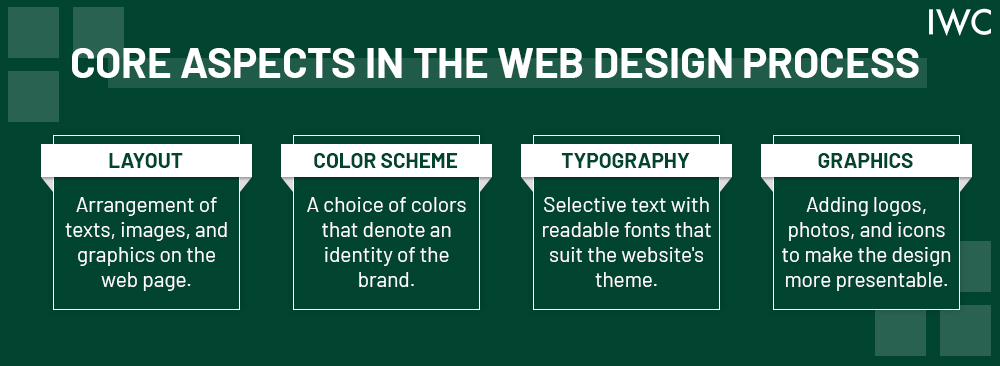
- Layout : Arrangement of texts, images, and graphics on the web page.
- Color Scheme : A choice of colors that denote an identity of the brand
- Typography : Selective text with readable fonts that suit the website's theme.
- Graphics:Adding logos, photos, and icons to make the design more presentable.
Good website design also considers user behavior, SEO, and easy navigation to ensure that it is user-friendly and attractive to the target audience.
What is Responsive Web Design?
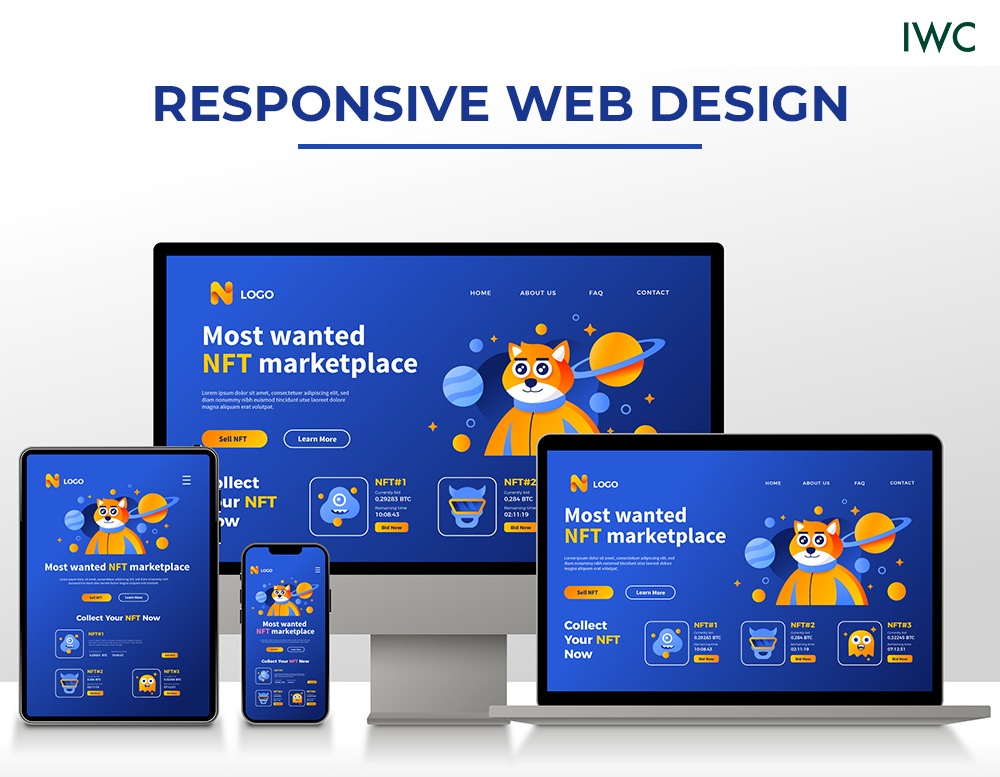
RWD is an approach that makes a website's design adapt and change according to different screen sizes-from the very large sizes of desktop monitors to the very small sizes of smartphones and tablets. The goal of responsive design is to provide an optimal viewing experience-easy reading and navigation of the content, whatever the device configuration.
One of the main elements involved in responsive web design includes
- Flexible Grids: A layout that adjusts with the size of the screen.
- Fluid Images:Images that scale up or down to adjust the screen size so that they are neither too large nor too small.
- Media Queries: CSS rules that apply specific styles based on device screen sizes.
Responsive design is actually a norm nowadays because the internet is accessed more on mobile devices than on desktops, or probably more. Therefore, having a responsive website is important in maintaining and attracting visitors.
What Do Web Designers Do?
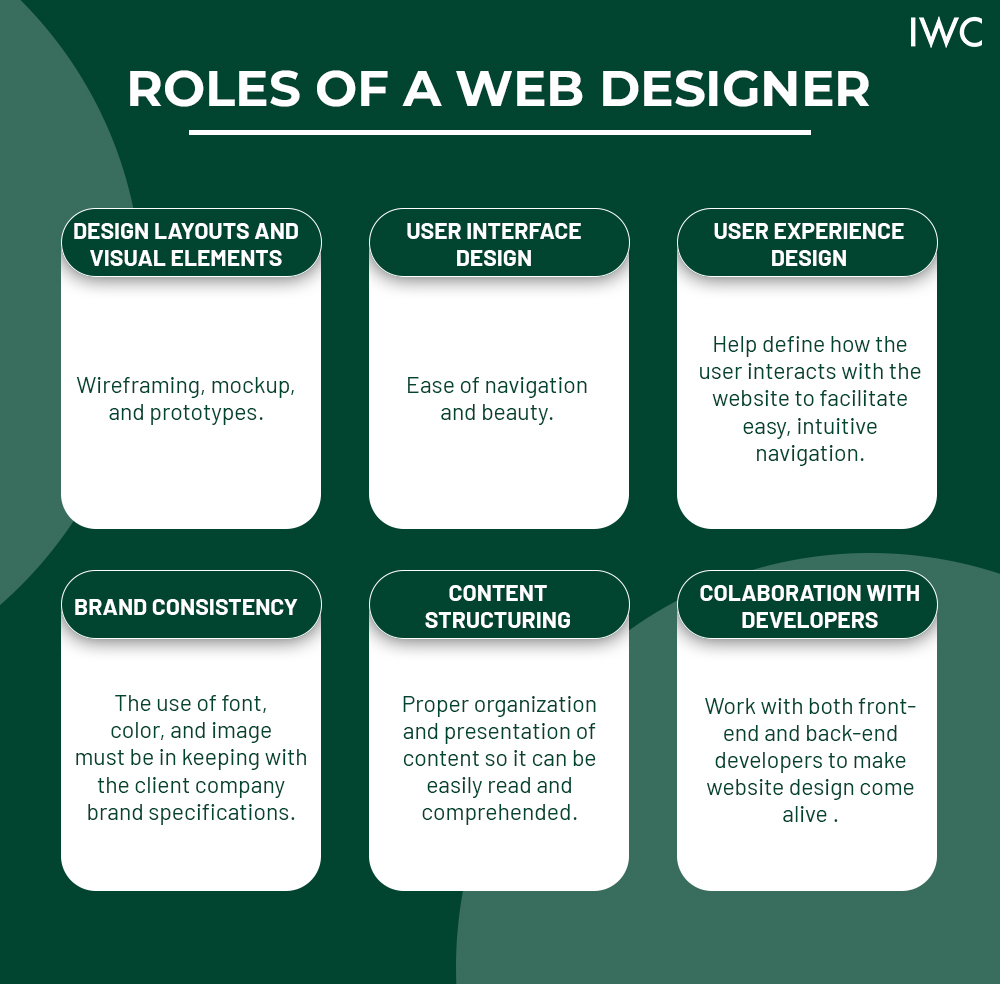
Web designers ensure that the website meets the desired look and feel. Their job encompasses a set of activities that involve creative as well as technical skills. They design aesthetically beautiful websites using various design tools and designing software that functions to serve the objectives of the client.
Roles of a web designer:
- Design Layouts and Visual Elements: Wireframing, mockup, and prototypes.
- User Interface Design: Ease of navigation and beauty.
- User Experience Design: Help define how the user interacts with the website to facilitate easy, intuitive navigation.
- Brand Consistency:The use of font, color, and image must be in keeping with the client company brand specifications.
- Content Structuring: Proper organization and presentation of content so it can be easily read and comprehended.
- Colaboration with Developers: Work with both front-end and back-end developers to make website design come alive .
Most web designers focus on particular disciplines, such as user interface (UI) design, UX design, or visual design. Some designers also have coding skills to make their designs come alive.
Key benefits of having a good web design
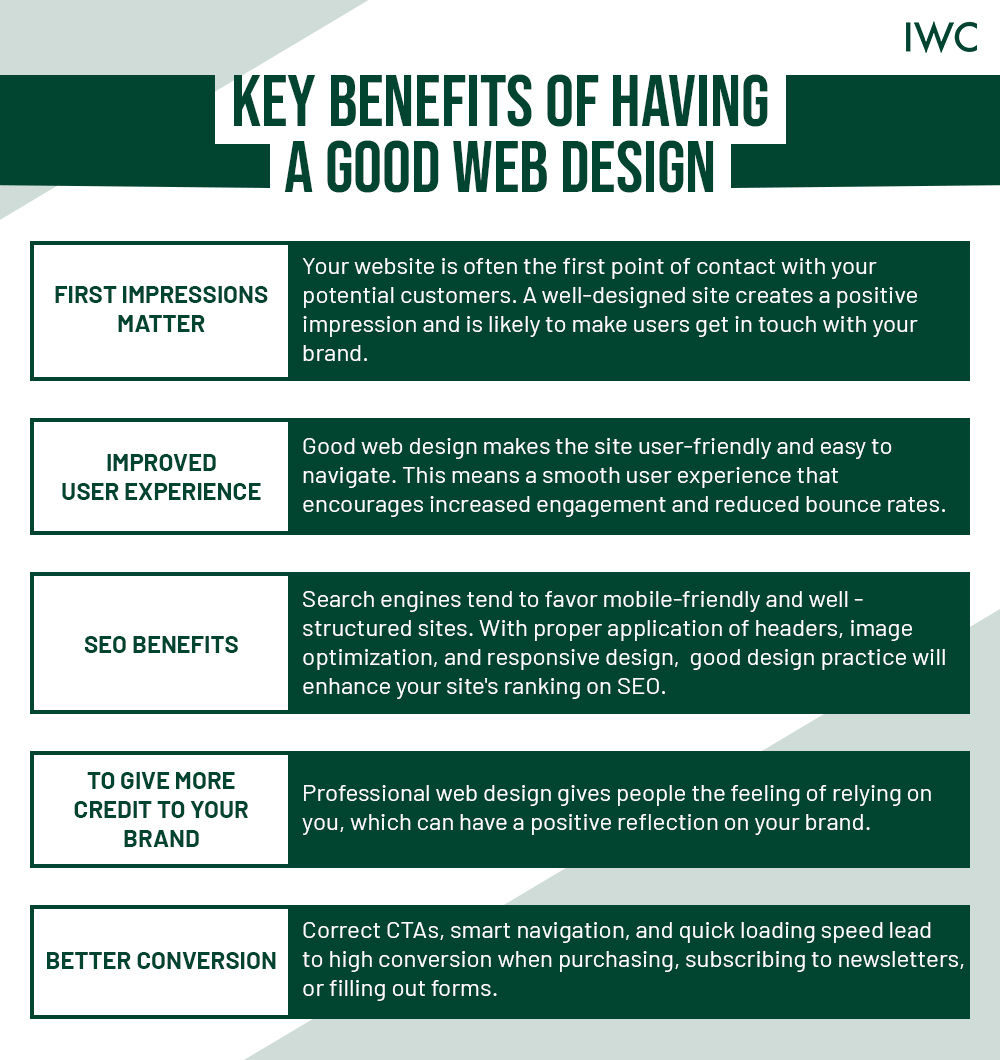
A well-designed website offers various benefits that can make a huge difference to your business. Here are the significant advantages of good web design:
- First Impressions Matter:Your website is often the first point of contact with your potential customers. A well-designed site creates a positive impression and is likely to make users get in touch with your brand.
- Improved User Experience:Good web design makes the site user-friendly and easy to navigate. This means a smooth user experience that encourages increased engagement and reduced bounce rates.
- SEO Benefits:Search engines tend to favor mobile-friendly and well-structured sites. With proper application of headers, image optimization, and responsive design, good design practice will enhance your site's ranking on SEO.
- To Give More Credit to Your Brand: Professional web design gives people the feeling of relying on you, which can have a positive reflection on your brand.
- Better Conversion:Correct CTAs, smart navigation, and quick loading speed lead to high conversion when purchasing, subscribing to newsletters, or filling out forms.
Basic Elements of Web Design
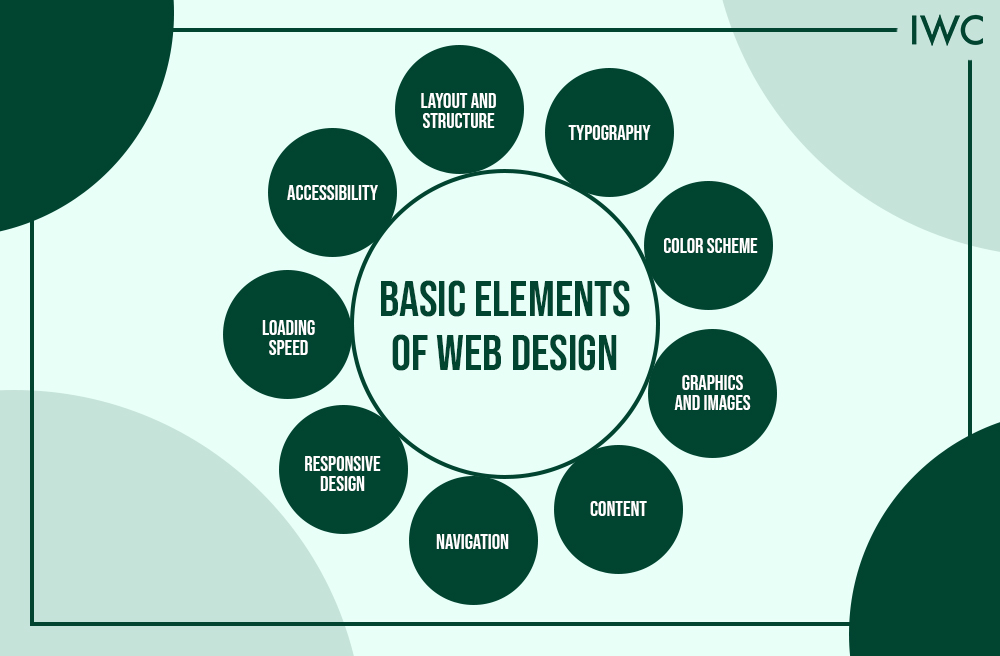
There are many core elements that define effective web design. Knowledge of such elements helps one in constructing or evaluating a web page worthy for the purpose of use.
- Layout and Structure: Good design means how the pieces or components of a webpage are structured. It can therefore guide users in a smooth way to locate certain items and travel through diverse sections of a website without encountering obstacles.
- Typography:
- choice of fonts is crucial in determining and communicating the readability and aesthetic features of the website itself. Suitable web-safe fonts ensure text is readable on all kinds of devices.
- Color Scheme: Colors evoke moods, and create a tone for what the website feels and perceives as a communication medium. A well-thought color palette is essential in attracting and engaging users and is usually based on the brand's identity.
- Graphics and Images: High-quality images, icons, and other graphical elements are used to support content and enhance the appearance of the website.
- Content: Well-organized, informative, and aligned with user intent are considered necessary characteristics of relevant and engaging content. This gives value to the visitor.
- Navigation: Navigation corresponds to how users navigate in a website. A sound structure for navigation assists in getting the information the users seek without frustration.
- Loading Speed: A slow-loading website will make users leave the site before loading. Optimizing images, enabling caching, and reducing code bloat are some examples that can be done in order to improve the load time.
- Responsive Design: This website needs to be responsive to the screen sizes so that access from any device is allowed. It improves both UX and SEO.
- Accessibility: A good web design ensures that the site is accessible to all users irrespective of whether they have disabilities or not.
Web Design vs. Web Development- WHAT is the difference?
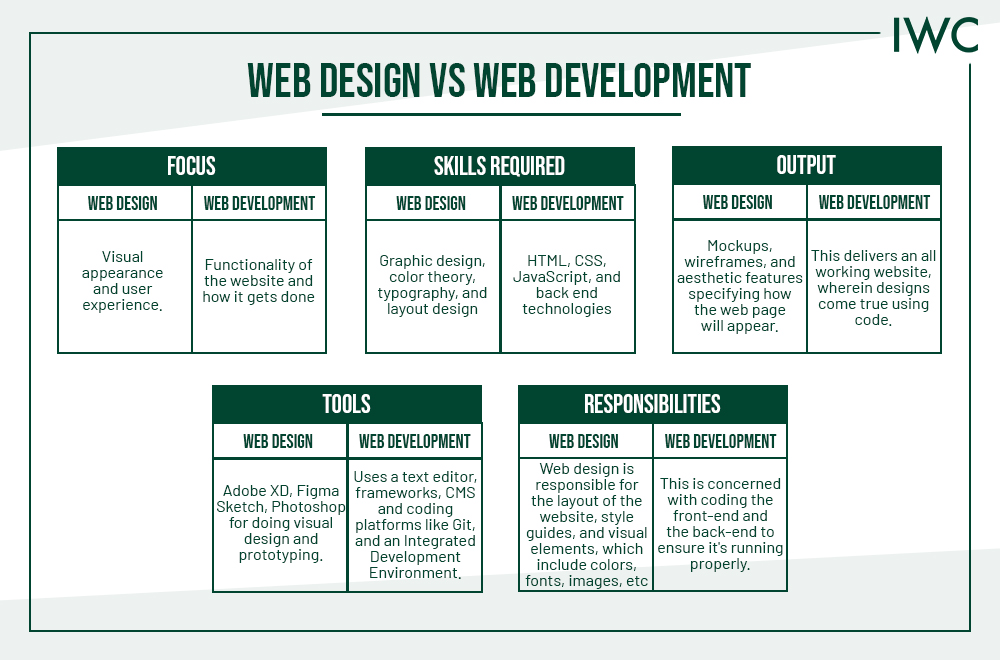
Focus:
- Web Design: Focuses on visual appearance and user experience.
- Web Development This refers to the functionality of the website and how it gets done.
Skills Required:
- Web Design This would include graphic design, color theory, typography, and layout design.
- Web Development This would include coding skills: HTML, CSS, JavaScript, and back end technologies.
Output:
- Web Design Outputs mockups, wireframes, and aesthetic features specifying how the web page will appear.
- Web Development This delivers an all working website, wherein designs come true using code.
Tools:
- Web Design: Uses tools like Adobe XD, Figma Sketch, Photoshop for doing visual design and prototyping.
- Web Development: Uses a text editor, frameworks, CMS and coding platforms like Git, and an Integrated Development Environment.
Responsibilities:
- As concerns web design. Web design is responsible for the layout of the website, style guides, and visual elements, which include colors, fonts, images, etc. As concerns web development: This is concerned with coding the front-end and the back-end to ensure it's running properly.
FAQs Related to Web Design
Here are some of the most common FAQs related to web design:
What is the importance of web design?
There are numerous reasons why web design matters. It plays an important role in creating the first impression any visitor has of your website; it determines the user experience and, consequently, the conversion rates as well. It also impacts your SEO.
In simple terms, what is the difference between UX and UI design?
UX (User Experience) design will focus on optimizing the user's journey to get through the site by making sure it is easy to use. On the other hand, UI (User Interface) design is more about what the website looks like and feels like, including its layout and visual elements.
How much does a web design cost?
The cost of web design varies with the complexity, experience of the designer, and requirements of the project. A simple website can range from $1,000 to $5,000 while complex sites into tens of thousands.
What tools do web designers use?
For a website design, a website designer in India would work on creating layout and visual elements using tools like Adobe XD, Figma, Sketch, Photoshop, and InVision.
Do web designers need to know coding?
While it is not necessary for a web designer to know how to write code, familiarity with HTML, CSS, and JavaScript is worthwhile, mainly when collaborating with other web developers .
What makes a good web design?
A good web design is aesthetically pleasing, user friendly, responsive, fast, and accessible to all users
Conclusion
Combining creativity with strategy and technical know-how, web design is truly an all-encompassing profession. A well-designed website makes for a fantastic tool in establishing a solid online presence, delivering an optimal user experience, and contributing to business growth.
Understanding the main elements of web design, the role of responsive design, and what distinguishes design from development can help businesses create or develop their own website more effectively. When one runs a business or seeks to become a web designer, it is taken for granted that one becomes adequately familiar with the nitty-gritty of web designing.
Also Read: How to Choose the Best Website Designers in India


